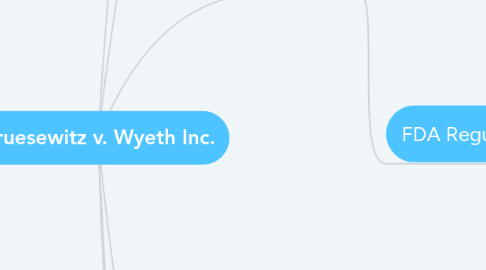
1. Facts
1.1. Parties
1.1.1. Russell Bruesewitz, et al.
1.1.2. Wyeth, Inc., (Wyeth Laboratories), et al.
1.1.2.1. Lederle had actully produced the DPT vaccine in question.
1.1.2.1.1. Lederle was acquired by Wyeth thus assuming all liabilities
1.2. What happend
1.2.1. In 1992, Hannah Bruesewitz received her routine 6-month DPT vaccine and within 2 hours started to have seizures.
1.2.1.1. After hospitalization and medical treatment her seizures persisted. Her parents filed a suit to claim damages from DPT vaccine made by Wyeth Lab. on the basis of faulty design.
1.2.2. Her parents filed claim in Federal Court of Claims
1.2.2.1. Unfortunately just few month before her parents filed the claim, seizures were removed as a basis for claiming injury due to vaccines.
1.2.2.1.1. Her parents claim was denied
1.3. Procedural History
1.3.1. The initial claim was filed in a state court in Pennsylvania. Brueswitz's claim was denied.
1.3.2. A federal judge agreed with the state court and dismissed the lawsuit. In the opinion, judge noted that the National Childhood Vaccine Injury Act protected Wyeth from legal action from vaccine related injuries. .
1.3.3. The U.S. Court of Appeals for the 3rd Circuit affirmed the lower court's decision.
1.3.4. Case was taken up by the Supreme Court
2. Issues
2.1. Did National Childhood Vaccine Injury Act protected Wyeth Inc. from product liability lawsuits for damages occurring as a result of a vaccine?
2.2. Do vaccine manufacturers still bear from responsibility for damages caused by vaccine under strict product liability?
3. Rules
3.1. National Childhood Vaccine Injury Act 1986
3.1.1. Was created by congress to stabilize vaccine manufacturers market
3.1.1.1. Prior to 1986, manufacturers were faced with hundreds of lawsuit from injuries resulting from vaccine
3.1.1.1.1. This threatened the supply of vaccine for public health good
3.1.2. Shielded manufacturers from credible or frivolous lawsuits
3.1.2.1. Manufacturers produced vaccine to ensure stable supply of vaccine in the U.S.
3.1.2.1.1. Vaccine still were subject to extensive testing and approval by the FDA
3.1.3. created a no-fault injury compensation program
3.1.3.1. Claimant had to file injury claims in a special court called Court of Federal Claims, naming the Health and Human Services Secretary as the respondent
3.1.3.1.1. Injured parties were entitled to cash compensation
3.1.3.1.2. Most expenses related to filing claims (such as attorney fees) were also covered
3.1.3.1.3. Court of Federal Claims, naming the Health and Human Services Secretary as the respondent
3.1.3.1.4. Court of Federal Claims provided a speedy mechanism to compensate injured person rather than lengthy tort claims process.
3.2. FDA Regulations
3.2.1. Vaccines are extensively tested and approved by the FDA before they can be used in the U.S.
3.2.2. FDA also requires manufacturer to test and trial the vaccine before approval
3.2.2.1. Safety and efficacy is main concern in the approval process
3.2.3. Post marketing surveillance is required to ensure that new side effect are noted when vaccines are widely used
4. Analysis
4.1. Is there a basis for injury claim
4.1.1. Was the injury (seizures) caused by the DPT?
4.1.1.1. The Claimants alleged that DPT vaccine was the cause of the seizure
4.1.1.1.1. Hannah suffered serious and probably lifelong illness
4.1.1.2. The defendants had ample ground to argue against the DPT causing seizure in Hannah's case
4.1.1.2.1. The timing of seizure within 2 hours of the vaccine administration is suspect.
4.1.2. Did Wyeth intentionally caused the injury?
4.1.3. Did Wyeth used defective design and could have used a safer DPT vaccine? (see below)
4.2. Is there a tort liability for causing injury
4.2.1. Tort liability is based on three factors: defective manufacture, inadequate directions or warnings, and defective design
4.2.1.1. NCVI statutes only mention manufacture and warning.
4.2.1.1.1. The NCVI states that manufacturers do not bear liability "if the injury or death resulted from side-effects that were unavoidable even though the vaccine was properly prepared and was accompanied by proper directions and warnings"
4.2.1.2. Does this mean that Wyeth remains liable if vaccine by design or by inclusion of certain chemical rendered it harmful?
4.2.1.2.1. However, Section 300aa–22(b)(1) of the NVIA seems to suggest that vaccine design (if properly manufactured and approved) is protected from tort liability.
4.3. Restatement of Torts (Second)
4.3.1. The Restatement of Torts (Second) exempts “unavoidably unsafe products” from strict liability.
4.3.1.1. By accepting DPT vaccine, did parents of Hannah accepted reasonable risks associated with Vaccine?
4.3.1.1.1. By consenting, did parents accepted side effects of DPT including very serious side effect such as seizures?
4.3.2. NCVI provides a mechanism to compensate for injuries resulting from vaccines
4.4. National Childhood Vaccine Injury ACT of 1986
4.4.1. Protected manufacturers from product liability
4.4.1.1. Congress realized that there is overwhelming public interest in stabilizing vaccine market
4.4.1.1.1. Excessive injury claims against vaccine would have driven the vaccine manufacturer out
4.4.2. The NCVIA created special fund by taxing vaccine
4.4.2.1. The Law realizes that, even though, vaccines are very safe, rare adverse effects are inevitable
4.4.2.1.1. By diverting tort and preempting tort cases to Federal Claims Court, the Law created a faster way to compensate for injuries caused by vaccine
4.4.3. Was Hannah's seizure caused by DPT vaccine from Wyeth
4.4.3.1. Hannah's parents had filed the initial claim to Court of Federal Claims
4.4.3.1.1. However, their claim was not deemed credible and their petition was denied
5. Conclusion
5.1. Supreme Court Decision
5.1.1. 6 to 2 decision. Majority decision written by late Justice Scalia.
5.1.1.1. "The NCVIA's "no-fault" compensation program preempts design-defect claims against vaccine manufacturers brought by plaintiffs seeking damages for injury or death caused by vaccine side effects."
5.1.2. Justice Sotomayor wrote the dissenting opinion
5.1.2.1. She argued that congress had not intended to provide vaccine manufacturer total immunity from torts and manufacturers are required to use best design for their vaccine.

